The Auschwitz Gas Chamber
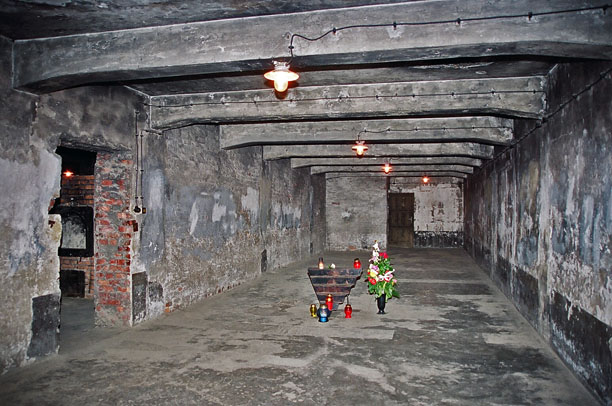
The gas chamber in
the main Auschwitz camp, Oct. 2005
The Krema I gas chamber in the main Auschwitz
camp, shown in the photo above, is a reconstruction which was
done by the Soviet Union in 1947. The original gas chamber had
been converted by the Germans into an air raid shelter in September
1944. A new entrance door, which can be seen in the background
of the photo above, had been added. In September 1944, the original
gas chamber had been divided into four small rooms. In the photo
above, you can see the reconstructed opening into the oven room
on the left hand side. This opening had been closed up when the
gas chamber was converted into an air raid shelter. During the
reconstruction, the opening into the oven room was moved a few
feet.
The photo above was taken with flash;
the room is actually very dimly lit and looks much darker. This
YouTube video shows what a tour of this chamber is
like today.
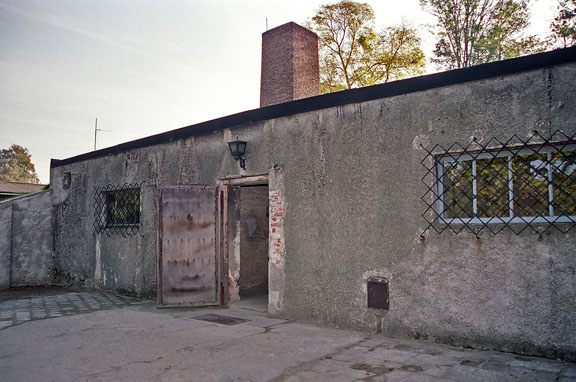 Original entrance into
Auschwitz gas chamber, Oct. 2005
Original entrance into
Auschwitz gas chamber, Oct. 2005
The photo above shows the original entrance
door into the crematorium building at the Auschwitz main camp.
This is the door that tourists now enter to see the gas chamber,
and it is the same door that the victims entered. According to
the detailed construction plans for the air raid shelter, the
windows shown in the photo were added in 1944. A
close-up of the entrance door is shown in the photo below.
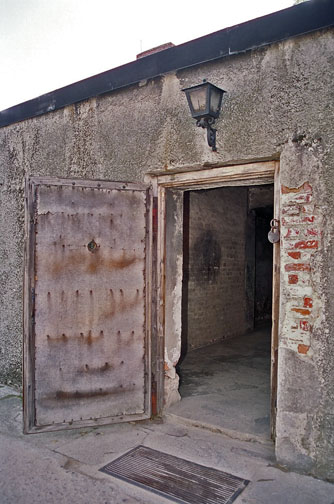 Close-up of original
entrance door, Oct. 2005
Close-up of original
entrance door, Oct. 2005
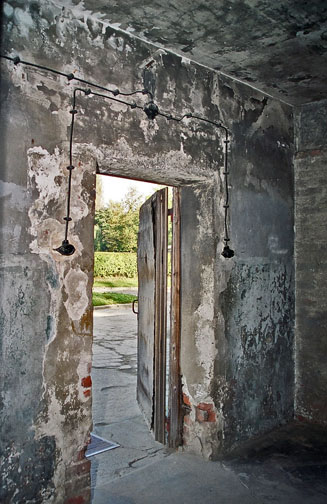 Entrance door as seen
from the inside, Oct. 2005
Entrance door as seen
from the inside, Oct. 2005
Filip Müller, a prisoner who worked
in the crematorium in the main Auschwitz camp, testified at the
Auschwitz trial conducted by the German government at Frankfurt
in 1964. A few years later, he wrote a book about the Auschwitz
gas chamber, entitled "Eyewitness Auschwitz, Three Years
in the Gas Chambers."
The door shown in the photo above was
described by Müller, who wrote that after the victims were
herded through this door, "two SS men slammed shut the heavy
iron-studded door which was fitted with a rubber seal and bolted
it."
In his book, Müller described how
Max Graebner, the head of the Political Department, a branch
office of the Gestapo, which was located next door to the gas
chamber building, stood on the flat roof of the building and
addressed the victims who had to assemble outside in the yard
in front of the door shown above. He would tell the Jews that
they had been brought to Auschwitz to work, but first they had
to remove their clothing and then enter the building to take
a shower, after which they would be given hot soup.
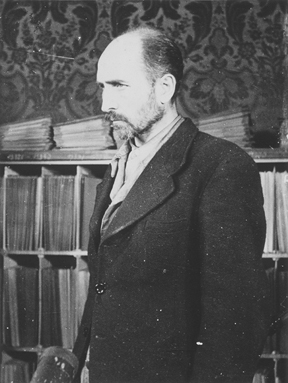 Max Graebner
Max Graebner
At first, the victims were driven inside,
fully clothed, by SS guards wielding clubs and whips, according
to Müller, who was assigned in May 1942 to remove the clothing
of the victims after they were gassed in the main Auschwitz camp.
The victims had carried their luggage inside with them and Müller
described how he ate some of the cheese that he found in a suitcase
inside the gas chamber.
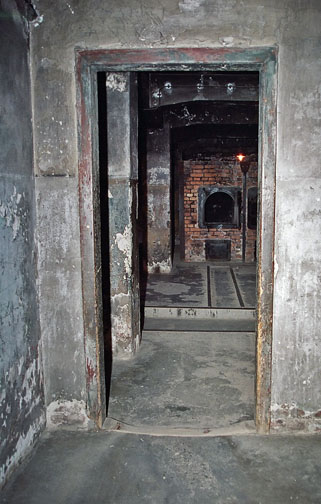 View of the cremation
ovens from the door into gas chamber
View of the cremation
ovens from the door into gas chamber
The entrance into the gas chamber in
the main Auschwitz camp is through an outside door which opens
into a vestibule that is about 6 feet by 8 feet in size. Inside
the vestibule, there is a door straight ahead, shown in the photo
above, which opens into the oven room, and another door on the
right, but out of camera range, that opens into a small room
which was a "laying out" room when this building was
used as a mortuary.
When the building was converted into
an air raid shelter, the "laying out" room became the
"surgery" room; it has a floor drain and was previously
furnished with wash basins. According to the Auschwitz Museum,
the "laying out" room "was used to store spare
gratings" when the morgue was converted into a gas chamber
in September 1941.
The photo below shows the door from the
vestibule into the laying out room. Inside this room, you can
see the door that originally opened into another small room which
was used as a washroom. The wash room wall was removed during
the reconstruction of the gas chamber in 1947, and the door from
the laying out room now opens directly into the gas chamber.
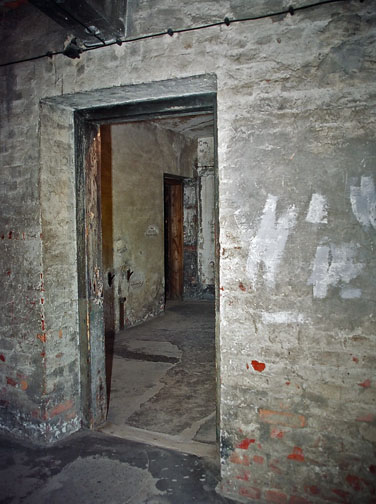 Visitors enter the
gas chamber through the "laying out" room
Visitors enter the
gas chamber through the "laying out" room
When the morgue room was converted into
a gas chamber, the laying out room was not used as such and there
was no morgue to store the bodies of prisoners who had died from
disease. The interior door into the reconstructed gas chamber
from the laying out room is shown in the background of the photo
above.
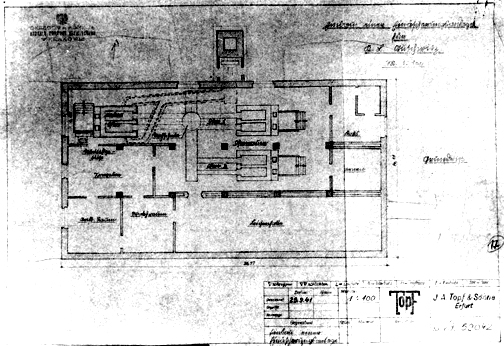 Original Blueprint
of crematorium and morgue in Auschwitz main camp
Original Blueprint
of crematorium and morgue in Auschwitz main camp
The photo above shows the original blueprint
for the Krema I building in the Auschwitz main camp. The morgue,
shown on the bottom right of the blueprint, has a door into the
oven room and another door into the washroom. The gas chamber
was in the same location as the morgue and it did not include
the area of the washroom. Note the door from the vestibule into
the washroom; this door no longer exists and the area of the
former wash room is included in the reconstructed gas chamber.
According to a guide book sold at the
Auschwitz Museum, the gas chamber in the main camp was only used
from September 1941 to March 1942 and after that, the gassing
of the Jews was done in "the little red house" and
"the little white house" just outside the Birkenau
camp. However, Danuta Czech wrote that the last victims were
members of the Sonderkommando, who were gassed in Krema I in
December 1942. The ruins of "the little white house,"
also known as Bunker
2, can be seen behind the Sauna building outside the Birkenau
camp.
Filip Müller was among the first
Jews brought to Auschwitz; he arrived in April 1942 and began
working in the crematorium in the main camp in May 1942. Regarding
the gassing of prisoners in the main camp, he wrote that "From
the end of May 1942 one transport after another vanished in this
way into the crematorium of Auschwitz."
The following quote is from Müller's
book, "Eyewitness Auschwitz":
At the same time, the siting of the
crematorium in the immediate vicinity of the camp was fraught
with danger: there was the distinct possibility that The Secret
Matter of the Reich could not remain hushed up forever, notwithstanding
its top-secret classification. It was for this reason that the
columns of deported Jews were conducted to the 'showers' either
at daybreak when the camp inmates were still asleep, or late
at night after roll call. On these occasions a camp curfew was
declared. To break it meant to risk being shot. For that same
reason those of us prisoners who had been forced to participate
in preparations for the extermination of Jews as well as in covering
up all traces of the crimes were divided into two groups. This
was to prevent us from pooling our information and obtaining
detailed knowledge of the extermination methods. Prisoners of
the second working party, the crematorium stokers, turned up
only after we had swept and thoroughly cleaned the yard. By the
time they arrived the chamber had already been aired and the
gassed were lying there as if they had just fallen naked from
the sky.
This page was last updated on May 31,
2009
|